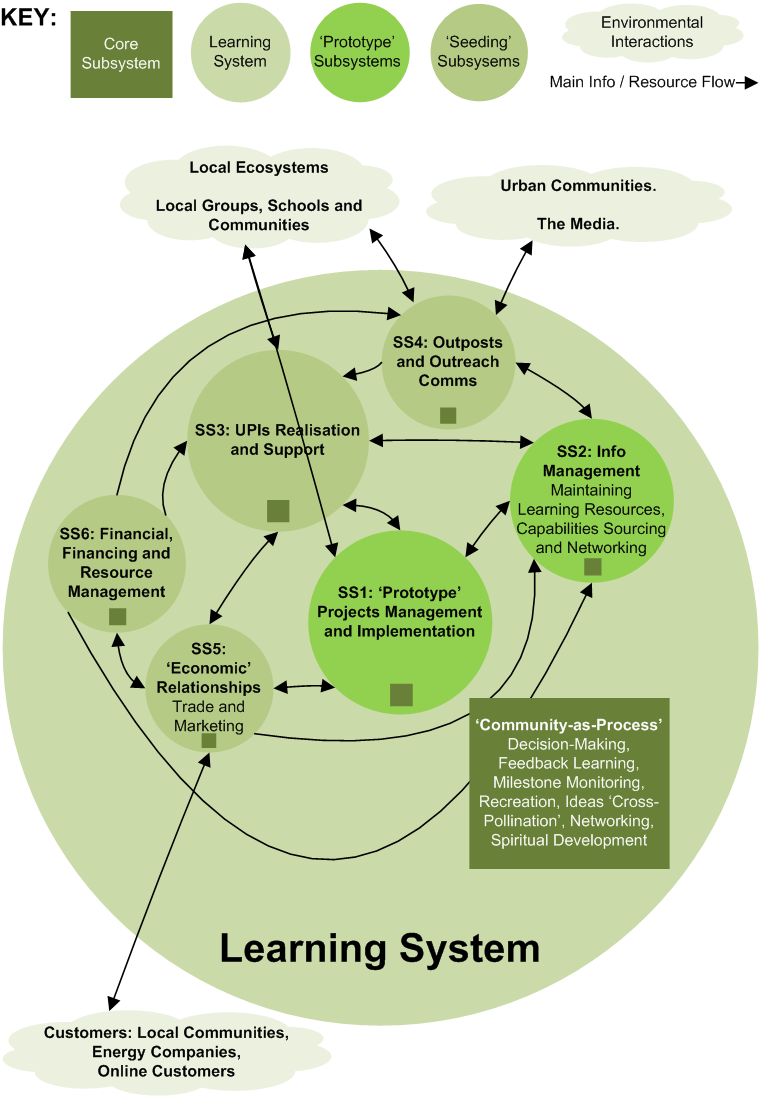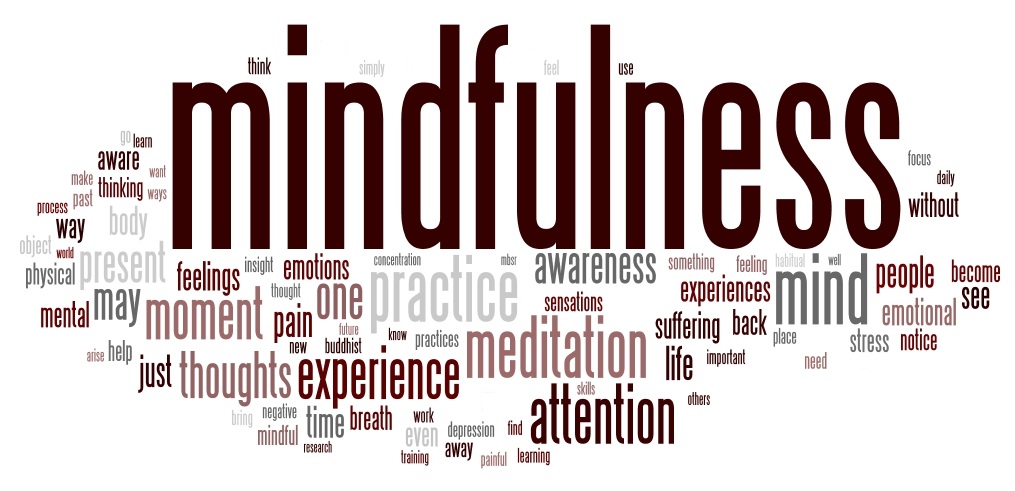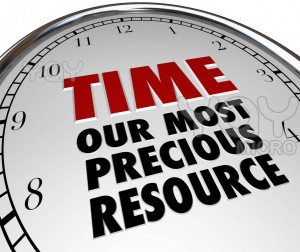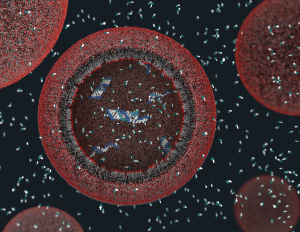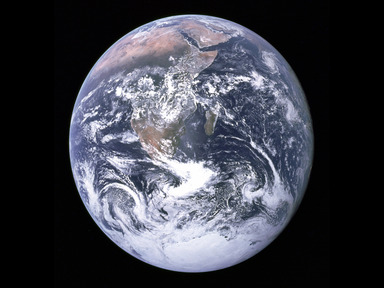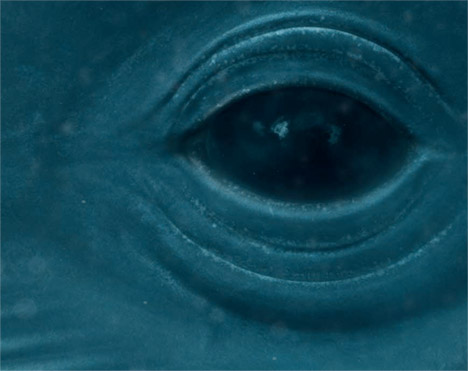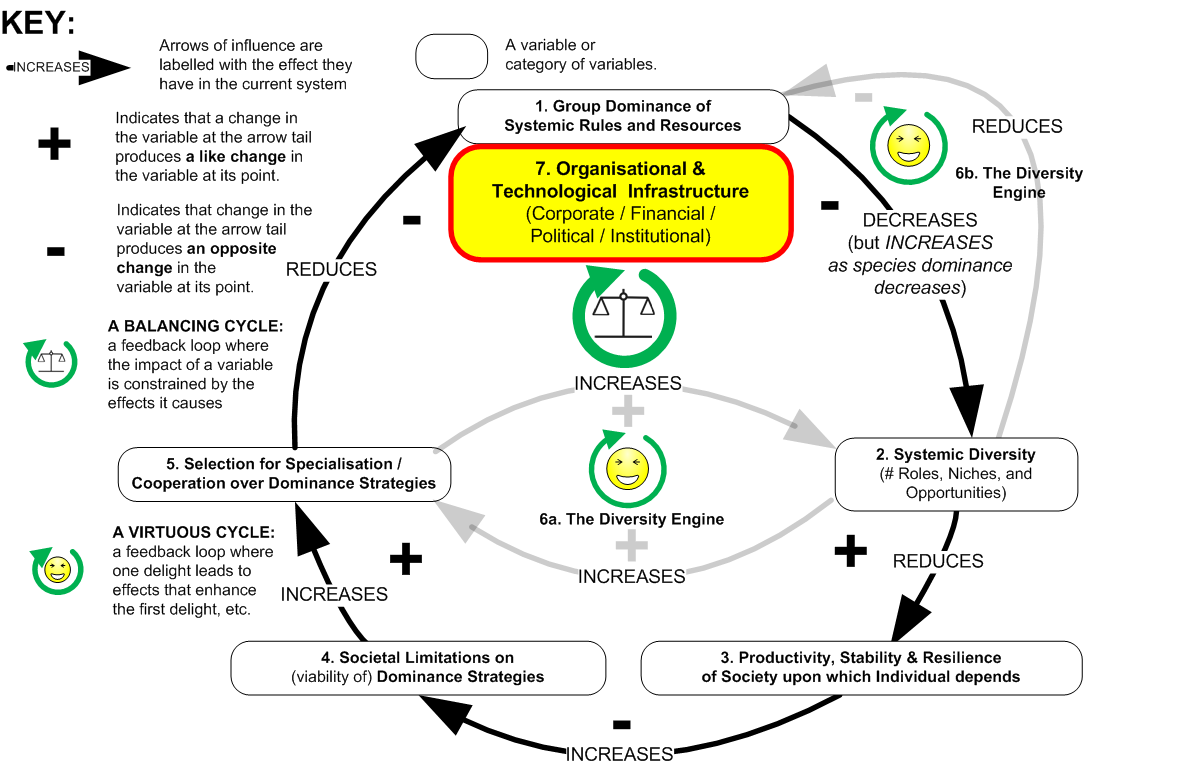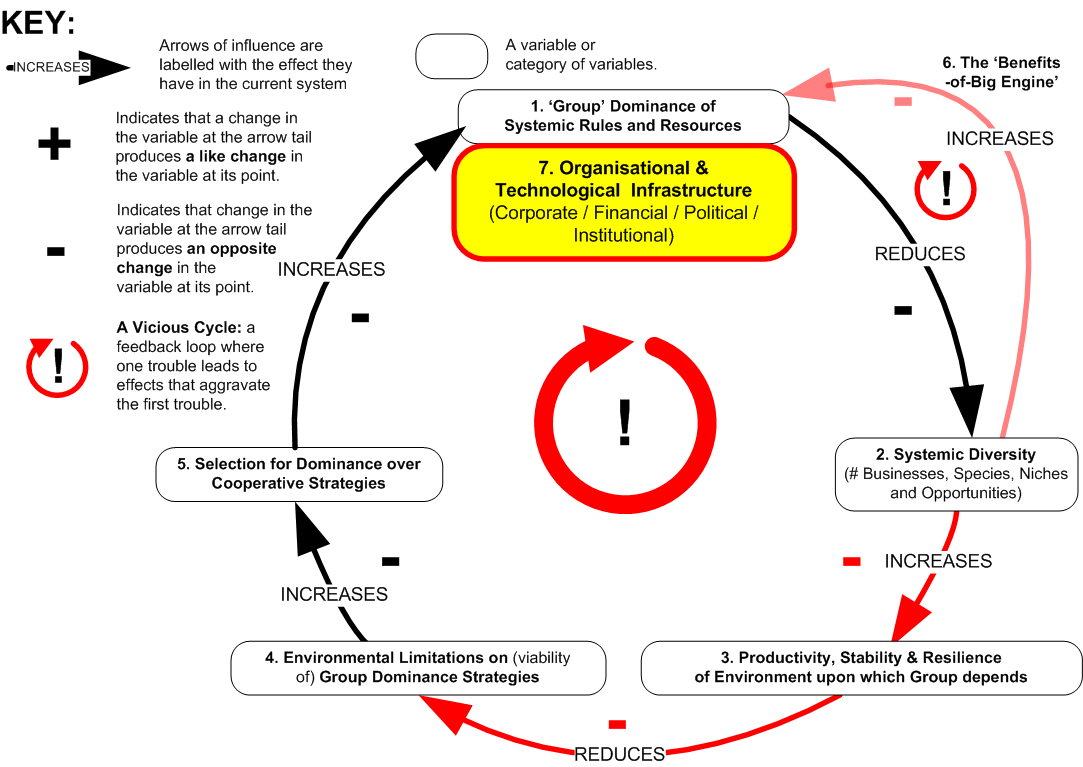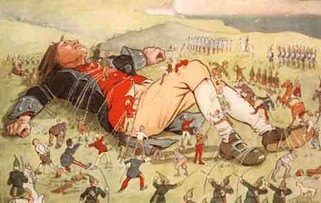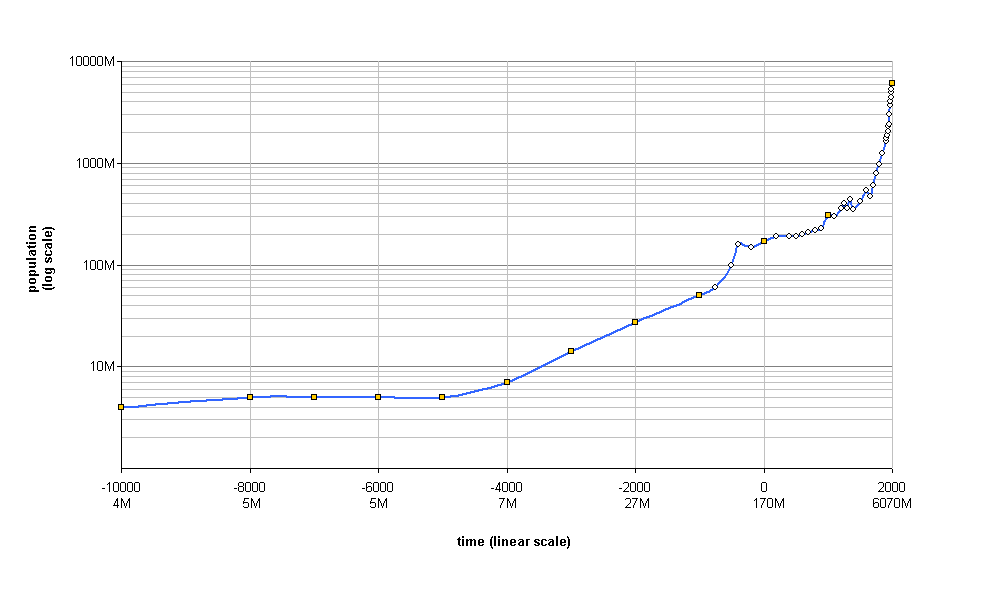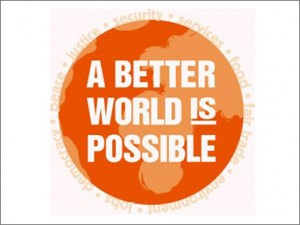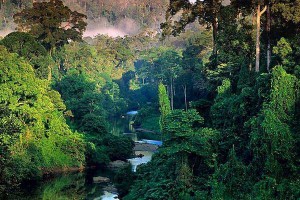Seeding a Viable Economic Alternative. Pt 2: The Principal Themes (Outcomes of a Systems Workshop at Future Connections 2012)
This is the second installment of a 4 part series about a soft systems workshop Arkadian ran with 20 PhD candidates at the Future Connections Conference 2012 in St Andrews, all of whom were conducting PhD Research on the theme of Sustainable Development.
Previously, we outlined the workshop structure, and described the session’s major outcome: an Action Plan for seeding a nationwide Viable Alternative to the current economic system. In the last two installments, Arkadian will be venturing some personal thoughts relating to the session outcomes that emerged during the analysis.
This week, however, we will be exploring four Themes that pervaded the discussion about a Prototype Community that might seed a Viable Alternative. As mentioned previously, some ideas here (and in Part 3 and 4) will be developed beyond the original session content as a result of their transaction (via Arkadian) with an ongoing experiment in developing an socioeconomic alternative (‘Wisdom Economy’) on the Isle of Bute: An Tearman.
1) Stewardship of the Diversity, Integrity and Beauty of the ‘Community-of-Interdependence’ (Nature first). It was generally agreed that, if the Community was to have a single guiding principle it should be the pursuit of a reverent partnership with Mother Nature. This combines active observation and experimentation, to enrich our objective understanding of Her systemic workings, and activities which promote a deeper experiential connection, and appreciation of Her intrinsic value.
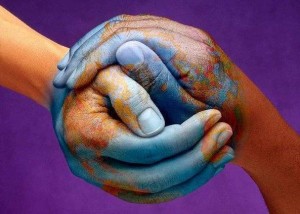 Although we place Nature first, as concerns practicing empathy for other and placing systemic needs above our own, our values are equivalent towards both Her and Our Community. We aim to cultivate individual awareness that the two are not separate but together constitute a single Community-of-Interdependence within which every ‘being’ performs a substantive role.
Although we place Nature first, as concerns practicing empathy for other and placing systemic needs above our own, our values are equivalent towards both Her and Our Community. We aim to cultivate individual awareness that the two are not separate but together constitute a single Community-of-Interdependence within which every ‘being’ performs a substantive role.
The fundamental goal of the Viable Alternative is to establish an equilibrium where we receive our material and non-material needs as a byproduct of enlightened care for the Community-of-Interdependence, with Nature taking priority. In pursuit of this, we complement Her strategies of achieving systemic integrity, productivity and beauty through diversity, reciprocity and work excellence in our approaches to the local ecology and our social milieu.
2) Performative Knowledge and Learning (Community-as-Process). How a rag bag of individuals, and hang-ups, might operate together effectively, ethically and enjoyably was probably the main, if subliminal, preoccupation of the session. Ultimately, this led to the group insight that ‘Community’ is a continuous reinforcing process, and not a ‘place’ or ‘entity’ as the concept is more commonly used.
 To think and act as a unit (‘togetherness’, ‘belonging’, ‘sharing’), our individual purpose, needs and experiences need to braid and coalesce with each others’. This couldn’t happen without the Structure, Principles and, particularly, the Time that would enable the Community to successfully plan, work, have fun and be together.
To think and act as a unit (‘togetherness’, ‘belonging’, ‘sharing’), our individual purpose, needs and experiences need to braid and coalesce with each others’. This couldn’t happen without the Structure, Principles and, particularly, the Time that would enable the Community to successfully plan, work, have fun and be together.
Also considered essential to acting as a unit is the ability for all members to have some grasp of the whole ‘blueprint’ of their particular Community project and, thus, an appreciation of the role, value and interdependence of all actors and activities therein. This requirement for inclusive participation in, and understanding of, the whole picture, in turn, implies limitations on the scope, size and organisation of the ‘units’ that comprise the wider Community System.
Moreover, there are no ‘experts’ here. Other, that is, than the Community itself. We consider the only real knowledge and learning is that which arises from, and returns to, our collective performance.
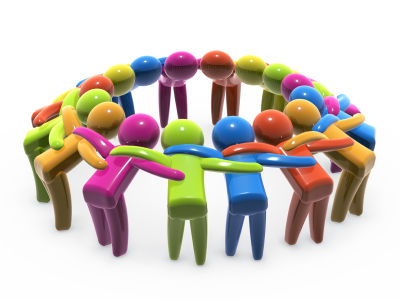 Know-how, erudition, irreverent cross-disciplinary romps, naive childlike experimentation, error and dispassionate collective assessment are all celebrated contributors to our ultimate purpose: a continuous social learning process that calls forth the unknown and unknowable world of the Viable Alternative. In this milieu, articulated knowledge functions as a part of collective activities rather than as an expertise that structures performance from without.
Know-how, erudition, irreverent cross-disciplinary romps, naive childlike experimentation, error and dispassionate collective assessment are all celebrated contributors to our ultimate purpose: a continuous social learning process that calls forth the unknown and unknowable world of the Viable Alternative. In this milieu, articulated knowledge functions as a part of collective activities rather than as an expertise that structures performance from without.
Below is a diagram of a Viable Systems Model (VSM) representing the Community’s organisational structure, which demonstrates the centrality of Community-as-Process’ to its success. A VSM is a systems thinking tool that applies the metaphor of living organism to an organisation, representing its main purposeful transactions with the environment as ‘organs’.
Ordinarily, a VSM presumes an ‘Executive Subsystem’ that monitors and orchestrates the operations of the whole – the equivalent of, say, the ‘The Board’ or the Prefrontal Cortex. However, in the model of the Viable Alternative Learning System, the wisdom of the ‘Director’ has been displaced by that of the ‘Collective’, in the form of the social processes from which our shared self-organising and self-regulating vision emerges.
3) Respect and Empathy for The Experiences of Other. Key to the healthy functioning of ‘Community-as-Process’ is respect for the predispositions and experiential histories of our fellows, even when they give rise to motivations, perspectives and worldviews very different from our own. Necessarily, this also entails developing our aptitude for dispassionate self-examination, so that we may each reflect critically on the roots of our own models, assumptions and prejudices.
To address these inner challenges, our aim is that everyone become adept in the pragmatic application of ‘tools’ that promote mindfulness of self and other – meditation, yoga, mediation, facilitation, discussion circles, non-violent communication, nature connection and systems methodologies such as Rich-Picturing, SODA and SSM.
The practical objective of all this is, to the extent possible, decouple personal experience from its deep cultural (and possibly, natural) entanglements with status, identity and ego, so that it’s performative potential may blossom. Deconstructing our ivory towers to build bridges of consensus. Transforming Knowledge and Experience as immutable personal possessions, into Knowledge and Experience as a dynamic shared property that informs and feeds back from impersonal activities-in-the-moment.
All very well, I hear you say, but what about me? Where do my individual needs fit in and what happens when they diverge from those of the collective? After all, even big happy families stifle personal growth at times, don’t they?
 Making space for purely personal development, unsurprisingly, was another central theme of the discussion. As mentioned in the previous installment, a core design objective of the Prototype is to free a third of each week for each of us to pursue our own ‘becoming’ according to our own inclination. Our only constraint is that in exercising this right, we don’t impact negatively on the diversity, integrity and beauty of the Community-of-Interdependence.
Making space for purely personal development, unsurprisingly, was another central theme of the discussion. As mentioned in the previous installment, a core design objective of the Prototype is to free a third of each week for each of us to pursue our own ‘becoming’ according to our own inclination. Our only constraint is that in exercising this right, we don’t impact negatively on the diversity, integrity and beauty of the Community-of-Interdependence.
The Community may also allocate some of its own ‘activity and decision-making’ time to develop opportunities and environment in response to individuals’ identified or declared needs. This is deemed valuable work because it promotes diversity and redundancy, the magical underpinnings of productivity and stability for both Nature and Community.
 In summary, we take the view that a social system where individual variety, creativity and knowledge of the local natural environment flourishes according to its own will, where each node maintains positive interconnections to all others and contains the seed of the self-sufficient whole, and which can decide and mobilise effectively as a single organism, is one of optimal adaptability and resilience, and thus best equipped to face the environmental challenges of the future.
In summary, we take the view that a social system where individual variety, creativity and knowledge of the local natural environment flourishes according to its own will, where each node maintains positive interconnections to all others and contains the seed of the self-sufficient whole, and which can decide and mobilise effectively as a single organism, is one of optimal adaptability and resilience, and thus best equipped to face the environmental challenges of the future.
4) The Sanctity of Time for Community and The Individual had, by the end of the session, become a central mantra of the Learning System. Time is not perceived here as an abstraction, or an economic ‘obligation’, but as a resource of inestimable importance: the root source of those experiences most responsible for generating meaning, community and well being.
Thus, the need for the Viable Alternative to produce sufficient Time to satisfy our non-material requirements was a thread that pervaded the discussion. An indicator, possibly, of how overlooked, undervalued and misunderstood its role has become in the current economic system.
And so concludes our look at the principal 4 Themes underpinning the discussion, and of the outline of the session outcomes. We hope you’ll join in a fortnight for Part 3, where Arkadian will be discussing some personal views that emerged during the analysis.
What I Learned from Destroying the Universe
Happy New Year! Arkadian’s first blog of 2013 is a brief account of a recent, and surprisingly meaningful, personal experience of a natural system, and the important lessons learned.
Over the Christmas holidays, during a rainstorm, I took the dog for his usual walk in a local wood. En route there’s a place where I bridge a stream on a fallen tree trunk.
Halfway across, something caught my eye. Hovering above the swollen and fast-flowing water, was a perfect Giotto circle, white, saucer-sized. I got down on my belly for a closer look. It was an exquisite ‘universe’ of tiny bubbles, revolving clockwise peacefully, seemingly oblivious to the mayhem surrounding it (I didn’t have my cameraphone, so other ‘attractors’ this universe called to mind will have to be used instead for illustration. There is also a short video of a similar phenomenon at the end).
For 45 minutes I lay spellbound, trying to discern the dynamics underpinning its beautiful form and behaviour. Immediately, upstream a large rock, barely breaking the surface, split the current into three highly erratic patterns: a fast and a slow channel, and another that surged over the top in intermittent waves. These flowed either side of the universe and beneath it, respectively. Evidently, some eddy arising from their interaction was causing bubbles to organise as they did. But no matter how hard I studied, I couldn’t fathom how such chaos could have given birth to so elegant and serene an entity.
Eventually, my inner scientist could resist no longer. Reaching down, I put my little finger carefully onto the surface of the fast channel about a hand’s span from the edge of the universe. Pft! In a moment it disintegrated into a million bubbles, swept downstream on the torrent.
I waited a further 15 minutes, expecting the universe to reform. However, although random associations of bubbles coalesced from from time to time, none maintained location or integrity for more than a few seconds before being washed away.
The dog was palpably exasperated by this point, so we resumed our walk but returned for another look on the way home. Nothing. Most days since, I’ve passed this spot. Never have I seen the universe again.
So what three important lessons did I learn from destroying the universe?:
1. That no natural system is inevitable. Half of me still can’t accept that so robust a phenomenon could have been an accident. The little universe played a trick on my mind such that it seems inconceivable the specific environmental conditions in that area of the stream would never have given rise to it or will not again at some point in the future.
My other half, however, is now deeply humbled by a new certainty about uncertainty. The only reasonable conclusion it can draw from an honest review of the sporadic serendipitous coincidences by which a natural system, such as the universe, evolves from anarchic molecular storms, is that Fate and Destiny are tales told in hindsight. Nothing is meant to be. This half finds the thought oddly comforting.
2. That no natural system is independent of its wider environment. My intervention was based on a long and careful assessment of possible interrelationships between the universe’s behaviour and environment. I deemed the touch of my pinkie sufficiently gentle and distant from the core system to cause, at worst, a tiny perturbation that might afford some penetration of its workings.
But the universe depended on a context much wider and richer than I could have expected. Even within my narrow scope of observation, this singular micro-dance between pattern and (apparent) disorder defied any linguistic, mechanistic or mathematical generalisation.
That it also depended on the outlying point in the stream at which my finger interposed, however, drew my puny mind flailing into all the other dynamic factors vital to the universe’s becoming – the bubbles’ surface properties, the woodland shelter, the upstream topography, the rainfall intensity, the climatic pressure, and so on, inwards and outwards into a matrix of wholly interdependent and nested systems.
One can only quake in awe at the complexity, and in terror at the hubris of a culture that imagines it can reduce and conquer such prodigious abundance. The Modern Self thinks itself independent of its world and, thus, perceives the pieces of its world similarly: believing each can be treated in isolation. These are suicidal delusions it would do well to wake from.
3. That one shouldn’t be fooled by the apparent stability of a natural system. Although I never expected the universe to endure forever, its superficial calm, autonomy and resilience in relation to its riotous milieu communicated a permanence that would easily tolerate some interference. This was an illusion born from ignorance. The merest touch of my finger was all it took to disturb some hidden, fundamental control parameter, and initiate a total irreversible breakdown.
To summarise, it is my view that the universe was an impossibly fortuitous, complex, and mysterious accident (this includes my own ability to contemplate it). The illusion that I was separate from it, had mastery over it, and could assume its stability based on appearances alone was a recipe for disaster. The same assumptions likely hold for all natural systems, including the biosphere of the Earth.
What I learned from destroying the universe is that the wisest approach for humankind is to cultivate a new personal humility and responsibility towards the natural systems we experience every day: to intervene in their unique, context-specific lives with mindfulness and empathy, and to seek a partnership that follows their lead in all things. We have so much to learn.
We hope you’ll join us in a fortnight for our first major series for 2013: a model for seeding a nationwide viable alternative to the current economic system (co-created by a team of PhD candidates focusing on sustainable development).
*Since writing this blog, Arkadian came across a similar phenomenon in another stream, and this time took a video (see below). Whilst the current and context is radically more sedate, the behaviour is in many ways very similar to the instance described above and offers a good illustration.
Why Corporate Regulation is a Socioenvironmental Necessity. Part 5 of 5: How do We Create a Diverse and Stable Economic System?
Welcome to the belated final installment of our five part analysis. We have been working towards the title’s conclusion by seeking an answer to the following question.
What difference between natural / social, and economic, systems causes one to tend towards diversity and stability, and the other, uniformity and instability?
In installments 1, 2 and 3, we proposed that in natural / social systems a species or ‘group’ seeking total domination of their environment are constrained and, ultimately, destroyed by the impoverishing and destabilising effects of their actions on the systems upon which their own survival depends, thus leaving the arena open for dynamics that promote diversity and long-term stability (see previous installments if you need an explanation of the model below).
In installment 4 we suggested that the current economic system displays a reverse trend towards uniformity and instability because it allows the small ‘groups’ at the helms of corporations to gain increasing wealth and power from disintegrating social / natural systems without ever personally experiencing the environmental backlash of their actions. (see installment 4 if you need an explanation of the model below).
 To clarify, this shouldn’t be taken as a demonisation of businessmen. Some individuals are naturally entrepreneurial, status-driven or materially-oriented, and the prosperity and order we have come to enjoy in recent centuries are largely indebted to their spirit and energy. Indeed, there are few among us that wouldn’t pass up a lottery win and the prestige, security and freedom it affords.
To clarify, this shouldn’t be taken as a demonisation of businessmen. Some individuals are naturally entrepreneurial, status-driven or materially-oriented, and the prosperity and order we have come to enjoy in recent centuries are largely indebted to their spirit and energy. Indeed, there are few among us that wouldn’t pass up a lottery win and the prestige, security and freedom it affords.
However, in the current era, unconstrained profit-and-power motivated vicious cycles represent a mortal threat to our freedom of choice, quality of life and, most urgently, our planet’s life systems. If the virtuous feedback mechanisms that promote diversity and stability in natural / social systems do not function naturally in the current economic system, then they they must be imposed artificially with due haste. But how?
First let’s summarise, in a nutshell, the problem to be resolved…
In the current economic system, dominant ‘groups’ are able to benefit from abusing the diversity and stability of socioenvironmental systems without ever experiencing negative feedback from their actions.
Although many possible interventions occurred to Arkadian whilst writing this series, a coherent regulatory model, which offered an unobjectionable, easy transition from the current economic system was not so easy to imagine (the reason why the final installment has been so long in coming!). Happily, a fully-formed (40yr old) solution presented itself recently in Chapter 19 of ‘Small is Beautiful’, courtesy of the genius of economist, E.F. Schumacher (pictured left).
The Schumacher Business Model, stated simply, rests on 2 systemic ‘tweaks’: (1) limiting the number of people a single corporate entity can employ and (2) introducing meaningful public ownership and accountability into business structure and practice.
(1) Legally restricting corporation size by number of employees. It would seem reasonable that a ceiling should be dictated chiefly by evidence regarding effective human group size (see Dunbar’s number), say between 80-200 persons. Growth beyond the upper limit, Schumacher suggests, should entail the formation of new independent corporate units, which may be linked by joint stock. These restrictions would enable each employee to ’embrace the idea of the business as a whole’ and the value of their role therein, but most importantly to the current argument, it would ensure that ‘the group (i.e. The Board)’ couldn’t claim ignorance of the details of their company activities and, thus, could reasonably be held personally accountable for abuses.
Furthermore, constraining size, particularly when the exploitation of natural / social resources is involved, is also more likely to physically ground a corporation in a local environment. Bringing ‘the group’ closer to their employees and the raw coal face of their realworld transactions is likely to increase their susceptibility and responsiveness to negative socioenvironmental feedback both internal and external to their organisation. It is also liable to curb the scale of impacts of which a single corporate vehicle is capable.
All very well, the cynics may cry, but what of the ‘groups’ with the thicker skins and thinner moral fibre?
(2) Public Ownership and Accountability. Schumacher advises we put an end to annual corporate taxation (a proposition not disagreeable to most businessmen!). In its place he proposes that for every share sold privately by a company, a further share is issued to the public. Thus, as owner of 50% of the company, we’d collectively receive half of any dividends if and when they are paid out to shareholders (he argues that when a company grows beyond a certain size it loses its ‘private and personal character’ and thus can be considered, in a sense, a public enterprise anyway).
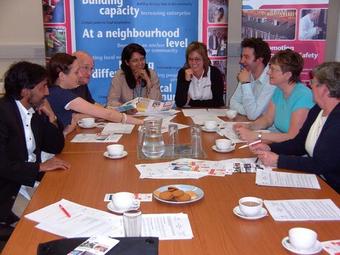 To avoid disruption, our public equity wouldn’t allow us any voting rights in everyday business decision-making. It would, however, entitle us to attend Board meetings as an observer and, if the actions of the business were deemed to run counter to the public or environmental interest, we could apply to a court to get dormant voting rights activated.
To avoid disruption, our public equity wouldn’t allow us any voting rights in everyday business decision-making. It would, however, entitle us to attend Board meetings as an observer and, if the actions of the business were deemed to run counter to the public or environmental interest, we could apply to a court to get dormant voting rights activated.
To exercise these corporate responsibilities, Schumacher proposes the creation of independent citizen bodies funded from local business dividends. These ‘Social Councils’ would be split into four equal parts: three would have their members nominated by local trade unions, professional, and environmental, organisations, with the final quarter being drawn randomly from local residents in the manner of jury service. Involvement in management processes would, of course, be bound by strict confidentiality agreements.
Schumacher’s model brings socioenvironmental feedback directly into the Board room both as a ‘possibility in the background’ and, when necessary, as a real, prevailing constraint.
It is Arkadian’s prediction that, over time, exposing the ‘groups’ at the corporate helm to these balancing dynamics would drive a new trend towards macroeconomic diversity and stability, and greater corporate responsibility for the integrity of the natural environment (by triggering the ‘Diversity Engine’, described in installments 1, 2 and 3). And to top it all, it would require minimal design and economic / legal restructuring because, in the main, the model utilises existing frameworks and practices.
To conclude, effective corporate regulation is not just a Utopian nice-t0-have. It took till 1960 for World Population to hit 3bn. It has grown by 1bn approximately every 12yrs since, probably hitting the 7bn mark earlier this year. There are more human beings to house and feed today than have ever lived before. Presently, we have just over 2 acres of workable land each, 4x less than a century ago, and this is shrinking each moment as corporate activities and climate change destroy the natural world, and population continues to skyrocket.
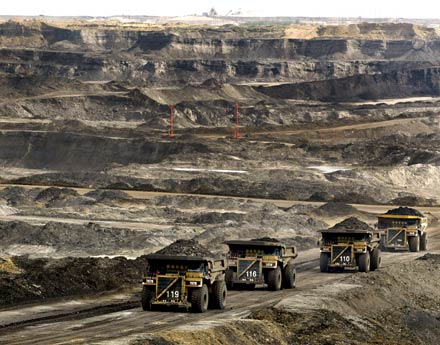 Resultant biodiversity loss, whilst often second-ranked in current ‘problem’ trends is, as we’ve established, probably the most dangerous of all due to its inscrutable relationship with macroenvironmental instability. With extinctions currently at 1000x the background base rate, and predicted to rise to 10,000x over this century, we are very rapidly, and very blindly, removing the Jenga pieces of our life systems, largely for the sake of the short-term wealth creation of the small ‘groups’ of the corporate elite. History is littered with exemplars of total societal and environmental meltdown as the result of human impact on vulnerable ecosystems: Easter Island, The Mayans, The Pueblo Culture of the South Western USA, the Norse Greenland and Iceland colonies to name but a few. If we repeat the same mistakes globally, we may not get a second chance.
Resultant biodiversity loss, whilst often second-ranked in current ‘problem’ trends is, as we’ve established, probably the most dangerous of all due to its inscrutable relationship with macroenvironmental instability. With extinctions currently at 1000x the background base rate, and predicted to rise to 10,000x over this century, we are very rapidly, and very blindly, removing the Jenga pieces of our life systems, largely for the sake of the short-term wealth creation of the small ‘groups’ of the corporate elite. History is littered with exemplars of total societal and environmental meltdown as the result of human impact on vulnerable ecosystems: Easter Island, The Mayans, The Pueblo Culture of the South Western USA, the Norse Greenland and Iceland colonies to name but a few. If we repeat the same mistakes globally, we may not get a second chance.
Considering the twin pincers of population growth and biodiversity loss, it is quite evident that socioenvironmental stability and sustainability are our most important objectives for the c21st, bar none. Our very survival depends on achieving them and success is contingent upon economic and environmental policy which is underpinned by the principle of diversity=stability=good. If variety is both the spice and source of life, then we must put democratic pressure upon Government and business to make the small tweaks to our economic system necessary for it to produce abundance by its own workings.
For a fascinating and vitally important lesson in the importance of preserving and promoting biodiversity, Arkadian cannot recommend the video below more highly. Essential viewing for all inhabitants of Planet Earth.
Why Corporate Regulation is a Socioenvironmental Necessity. Part 3 of 5: Why does A Diverse System = A Stable System?
Delighted that you’ve joined us for the third installment of our first Arkadian analysis for 2012, where over five short articles, we will show how we reached the series title’s conclusion by way of the following question: –
“What difference between natural / social systems and the current economic system causes the former to tend towards diversity and stability, and the latter, uniformity and instability?”
In Weeks 1 and 2, we investigated why ecosystems and ‘civilisation’ tend towards diversity and stability. It was proposed this was attributable to virtuous dynamics that promote long-term systemic stability and resilience by driving increasingly fine-grained specialisation / cooperation, whilst inhibiting environmental dominance by particular species or social ‘groups’.
Next week we will be putting forward an explanation as to why the current economic system displays the reverse trend but, for now, we thought it worthwhile to explain briefly the connection between diversity and stability. Why exactly does a change in the former result in a like change in the latter?
Put simply, in a diverse system, the health of the whole (‘productivity’) isn’t dependent on the performance of only a few parts.
 For example, imagine a disadvantaged family where Dad is the only breadwinner. If he has an accident, no-one eats. If the house blows down in a storm, there’s no-one to rebuild it. Compare the situation with a second family where several other members also contribute to the household income. Because ‘productivity’ is distributed across several people, the overall family ‘system’ is much more able to adapt to an accident-prone Dad and / or a force majeure.
For example, imagine a disadvantaged family where Dad is the only breadwinner. If he has an accident, no-one eats. If the house blows down in a storm, there’s no-one to rebuild it. Compare the situation with a second family where several other members also contribute to the household income. Because ‘productivity’ is distributed across several people, the overall family ‘system’ is much more able to adapt to an accident-prone Dad and / or a force majeure.
 A classic instance of systemic over-dependency at a macro-societal level is Ancient Egypt, which teetered on a single variable: the annual flooding of the Nile (taken from the excellent ‘Water’ by Steven Solomon). The ‘inundation‘, as it was known, rejuvenated the plains with fertile silt and washed away soil poisons, to produce the most self-sustaining and fertile farmlands of the ancient world.
A classic instance of systemic over-dependency at a macro-societal level is Ancient Egypt, which teetered on a single variable: the annual flooding of the Nile (taken from the excellent ‘Water’ by Steven Solomon). The ‘inundation‘, as it was known, rejuvenated the plains with fertile silt and washed away soil poisons, to produce the most self-sustaining and fertile farmlands of the ancient world.
The exclusive focus of the political elite was water management: senior priest-managers led departments for overseeing dikes, canal workers and measuring river levels; and top dog, Pharaoh’s, fundamental godly responsibility was mastery of the flow of the great river.
Unsurprisingly then, the Nile and Egyptian history ebb and flow in perfect synchronicity. Without exception, the Old, Middle, and New Kingdoms, as well as the later periods of Greek and Byzantine rule, bloom with the return of the regular cycle of flooding and crumple with climactic dry periods into centuries of disunity, chaos and foreign invasions. Thus, despite many environmental blessings, ultimately, the stability and resilience of this mighty civilisation and its elite were slave to the caprices of its one water source, in a way that a country with abundant springs, rivers and lakes could never be.
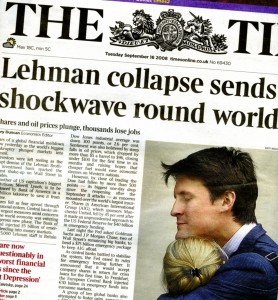 Our third and final example – the current economic downturn – illustrates uniformity and instability at a global level. Here, the world’s banking system was rendered so fragile by the interdependency of a few titanic banks and financial services firms, that massive external intervention was required to prevent total meltdown when one of them, Lehman Brothers, filed for bankruptcy in 2009. It is a crisis and an intervention for which we shall all suffer for many decades to come.
Our third and final example – the current economic downturn – illustrates uniformity and instability at a global level. Here, the world’s banking system was rendered so fragile by the interdependency of a few titanic banks and financial services firms, that massive external intervention was required to prevent total meltdown when one of them, Lehman Brothers, filed for bankruptcy in 2009. It is a crisis and an intervention for which we shall all suffer for many decades to come.
But why had the economic system not behaved like the natural / social systems we looked at in Weeks 1 and 2, and become increasingly diverse and stable as it expanded? We hope you’ll drop in next Friday to find out.
Why Corporate Regulation is a Socioenvironmental Necessity. Part 1 of 5: Why do Ecosystems tend towards Diversity and Stability?
 Happy New Year and welcome to our first Arkadian analysis of 2012. Over the next five weeks we will be working towards the conclusion of the title of the series by exploring the answer to a simple question: –
Happy New Year and welcome to our first Arkadian analysis of 2012. Over the next five weeks we will be working towards the conclusion of the title of the series by exploring the answer to a simple question: –
“What difference between natural / social systems and the current economic system causes the former to tend towards diversity and stability, and the latter, uniformity and instability?”
In a world where the latter now poses a mortal threat to the former, we considered this to be a question of some significance. Could we learn from the way natural / social systems self-regulate in a way that benefits all, to design an ecologically-and-socially-just economic system?
Our analysis will be set out in five short articles, launching Friday mornings throughout January and early February: –
(1) Why do Ecosystems tend towards Diversity and Stability? Friday 6th January 2012.
(2) Why does (did) Civilisation tend towards Diversity and Stability? Friday 13th January 2012.
(3) Why do Diverse Systems = Stable Systems? Friday 20th January 2012.
(4) Why does the Current Economic System tend towards Uniformity and Instability? Friday 27th January 2012.
(5) How do we create a Diverse and Stable Economic System? Friday 28th September 2012.
So without further ado, let’s move onto our first question of the series:
Why do Ecosystems tend towards Diversity and Stability?
As a general rule the longer that ecosystems remain undisturbed by external factors, the richer they become. The oldest – the rainforests – are estimated to hold over half of all species, despite covering only 6% of the Earth’s surface. Why should 70m years of evolution against a backdrop of dynamic climate fluctuations give rise to increasing variety and not just a few dominant species?
MODEL 1 of our analysis below proposes an answer (N.B. If you have trouble reading the text, click on the diagram to open it in a new browser tab and then refer back to the explanation here).
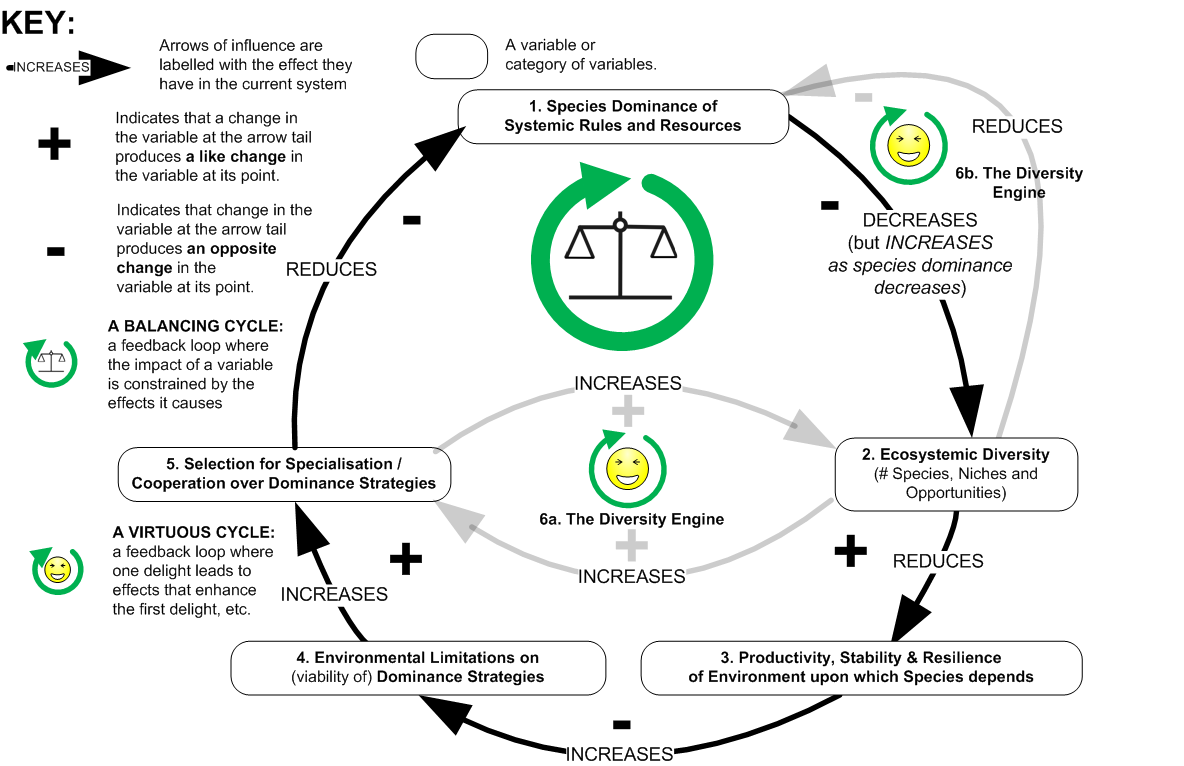 Begin at the topmost variable and follow the arrows clockwise around the loop. (1) Put yourself in the position of a species that pursues total dominance over its local environment. (2) Despite considerable early successes, it’s not long before your manipulation and consumption begin to impact adversely on other species. (3) As local biodiversity diminishes, so too do the health, resilience and stability of the ecosystem as a whole, (4) resulting in ever-tighter constraints on your actions and, ultimately, the collapse of the environment upon which your own survival depends. (5) Your extinction kills off that suicidal gene that motivated your thirst for dominance, leaving an open stage for adaptive strategies that promote ecosystemic diversity and stability.
Begin at the topmost variable and follow the arrows clockwise around the loop. (1) Put yourself in the position of a species that pursues total dominance over its local environment. (2) Despite considerable early successes, it’s not long before your manipulation and consumption begin to impact adversely on other species. (3) As local biodiversity diminishes, so too do the health, resilience and stability of the ecosystem as a whole, (4) resulting in ever-tighter constraints on your actions and, ultimately, the collapse of the environment upon which your own survival depends. (5) Your extinction kills off that suicidal gene that motivated your thirst for dominance, leaving an open stage for adaptive strategies that promote ecosystemic diversity and stability.
Thus, coming full circle, (1) Your Environmental Dominance Strategy proved self-defeating because it led to Ecosystemic Weaknesses that constrained and, ultimately, negated, You! In Systems Dynamics a feedback loop like this where the impact of a variable is reduced by the effects it causes is called a ‘Balancing Circle’.
 A further notable dynamic here is a pair of ‘Virtuous Circles’ (feedback loops where one delight leads to effects that enhance the first delight, and so on), which we’ve termed the ‘The Diversity Engine’.
A further notable dynamic here is a pair of ‘Virtuous Circles’ (feedback loops where one delight leads to effects that enhance the first delight, and so on), which we’ve termed the ‘The Diversity Engine’.
Here, (6a) the more the processes of natural selection incline towards interdependence, the more opportunities are opened up for new evolutionary adaptations. Thus, through increasingly fine-grained cooperation and specialisation between species, diversity itself drives diversity.
Moreover, as the environment grows ever more rich and complex, (6b) species dominance becomes increasingly futile and improbable, removing a further constraint on the trend towards diversity. And so both circles turn.
But (we hear you say) isn’t there a species that has had a radical effect on its local environment but has (thus far) escaped extinction? We hope you’ll drop in next Friday for Part 2, when we shall be exploring the curious exception of Homo Sapiens.
Recent Posts
- Seeding a Viable Economic Alternative. Pt 3: Placing Mother Nature First
- Seeding a Viable Economic Alternative. Pt 4: Ego-as-Process
- Charlie Hebdo and the Immorality Loop
- My Top 20 Waterfalls Pt3 (S America: #2-1)
- My Top 20 Waterfalls Pt2 (S America: #7-3)
- My Top 20 Waterfalls Pt1 (Africa, Asia, Europe & N America)
- Positive Change using Biological Principles, Pt 4: Principles in Action
- Positive Change using Biological Principles Pt 3: Freedom from the Community Principle
- Positive Change using Biological Principles Pt 2: The missing Community Principle
- Positive Change using Biological Principles, Pt 1: The Campaign Complex
- Seeding a Viable Economic Alternative. Pt 2: The Principal Themes (Outcomes of a Systems Workshop at Future Connections 2012)
- Seeding a Viable Economic Alternative. Pt 1: The Action Plan (Outcomes of a Systems Workshop at Future Connections 2012)
- What I Learned from Destroying the Universe
- Why Corporate Regulation is a Socioenvironmental Necessity. Part 5 of 5: How do We Create a Diverse and Stable Economic System?
- The Root of all Evil: how the UK Banking System is ruining everything and how easily we can fix it.
- What is Occupy? Collective insights from a ‘Whole Systems’ Session with Occupy followers
- Why Corporate Regulation is a Socioenvironmental Necessity. Part 4 of 5: Why does the current Economic System tend towards Uniformity and Instability?
- Why Corporate Regulation is a Socioenvironmental Necessity. Part 3 of 5: Why does A Diverse System = A Stable System?
- Why Corporate Regulation is a Socioenvironmental Necessity. Part 2 of 5: Why does (did) Civilisation tend towards Diversity and Stability?
- Why Corporate Regulation is a Socioenvironmental Necessity. Part 1 of 5: Why do Ecosystems tend towards Diversity and Stability?





